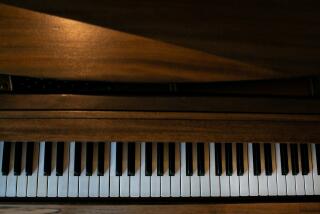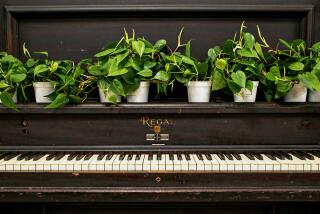Plaything for the serious player
- Share via
Pianist Phyllis Chen worried when she asked Andre Watts, her mentor at Indiana University in Bloomington, if she could use toy pianos for one of her doctoral recitals. After all, without his permission, the department wouldn’t even consider it.
Watts, more used to the standard classical repertoire, found the request surprising. But he listened closely to her proposal. “We’re talking for about 15 minutes,” Chen recalled recently, speaking by phone from New York, “when he suddenly said, ‘Oh, so you’re serious?’ ”
In the end, Watts agreed to listen to a CD she had made for him of her playing one of the 11 toy pianos she now owns. “I was nervous,” Watts says. “She was going to graduate or not graduate based on what people thought of this.”
He was won over, and so was the Indiana faculty. Now listeners in Los Angeles will have a chance to judge for themselves when Chen brings one of her toy pianos to Culver City for three recitals next Sunday as part of the Da Camera Society’s Chamber Music in Historic Sites concert series.
Chen will perform five pieces for toy piano, including John Cage’s seminal 1948 “Suite for Toy Piano,” interspersed with Baroque-era piano works by Bach (Partita in D) and Rameau (selections from “Pieces de Clavecin”) performed on a traditional concert grand.
One understands Watts’ initial concern. Toy pianos have been around since the mid-19th century, but only recently have they begun to be seen as serious musical instruments. There are toy piano factories, festivals and competitions throughout the world. There’s a toy piano website; there are blogs. The Library of Congress recently recognized the toy piano as an instrument, creating a special call number allowing toy piano scores to have their own shelf space.
What’s more, the catalog of toy piano pieces seems to be growing. Chen commissioned two concertos for toy piano last year, and a major one already exists: Aaron Jay Kernis’ ambitious 25-minute Concerto for Toy Piano, composed for a full symphony orchestra. Then there’s George Crumb’s 1970 “Ancient Voices of Children,” which hauntingly employs a toy piano and shows signs of attaining the classic status of Cage’s suite.
Odd tuning
Toy pianos are scaled-down -- way down -- replicas of full-size pianos. The smallest has one octave and fits in a backpack, but larger three-octave sizes, such as the Schoenhut “Louis XV” piano (“a perfect choice for any serious musician,” notes the Schoenhut website), weigh 45 pounds.
Their plastic keys are connected to metal rods and can generally be counted on to be out of tune. “It’s kind of just chance which toy piano sounds a certain way,” said Chen. “But I love the odd tuning, and there are a lot of passages in the Cage suite where he exposes the toy piano’s mechanical sound with repeated notes.”
That sound has been described as akin to a “tinkly” saloon piano, glockenspiel, xylophone, celesta or fortepiano. Its bright mechanical quality -- bing! -- can even remind one of a pinball machine. “It’s sort of like a harpsichord,” says composer and Bard College music professor Kyle Gann, whose 1994 “So Many Little Dyings,” based on a Kenneth Patchen poem, samples the toy piano.
Gann says Cage composed his “Suite for Toy Piano” during a period in which he was writing only quiet pieces for modest media. “He felt there was nothing good about anything big in society and that writing for the toy piano was almost a way of retiring from the official musical world.”
The toy piano may be a versatile little instrument, but performing on it is anything but child’s play.
Chen, who started studying piano at age 5, said that “just because I’m playing toy piano doesn’t mean that all that training disappears or is not evident somehow.”
Part of the fun of watching a grown person perform on a toy piano is that, like Schroeder in “Peanuts,” the musician must get close to the floor to play it. Chen sits on a cushion; others use an 8-inch-high bench.
According to Scott Paulson -- outreach coordinator at, appropriately enough, the Geisel Library at UC San Diego, named after Audrey and Theodor Seuss Geisel, better known as Dr. Seuss -- “the grand toy piano is the best one to use, because it’s a fun visual punch line when you lift the lid.”
Paulson, who owns 300 toy pianos on “permanent loan” to the Geisel Library, takes the instrument very seriously. He helped found a toy piano festival there, now in its ninth year. Fifty of his pianos are currently on display; many more are shown at festival time. “Some people are afraid of new music,” he says, “but you can’t be afraid of a toy piano.”
He also plays toy piano and offers a warning to composers. “It’s very easy to get a toy piano headache,” he says. He suggests combining the instrument with others that can play low and quiet. “The bass clarinet blends really well with toy piano.”
But Chen says, “it depends on who you’re talking to, because I can listen to a toy piano all day long.”
A raised status
As Chen explored the landscape of the toy piano, all roads seemed to lead to Margaret Leng Tan. She calls herself the “Big Mama” of the toy piano and Cage its “granddaddy.” Tan’s brilliant promotion of the tiny instrument in the 1990s culminated with her groundbreaking 1997 CD, “The Art of the Toy Piano.”
Tan will be one of the judges next fall for the second edition of “The UnCaged Toy Piano,” a competition for composers that Chen founded last year. She sees Chen as a good omen for the future of the instrument.
“I’m thrilled to see that it’s taken on a life of its own,” Tan says, “and that the toy piano has now become an established instrument. That was my whole aim -- to elevate it to the status of a real instrument.”
For Tan, who worked with Cage from 1981 until the day before he died in 1992, the composer is “the person from whom all this stems -- without him, we wouldn’t be doing this.”
“My one regret,” she adds, “is that I didn’t discover the toy piano until after he died. It’s a chameleon-like instrument that can be nostalgic, evoking memories of childhood. You can play Bach on it and it sounds like the voice of angels.”
She also notes that the instrument’s complex overtones can create “quite a sinister ambience.” She once accompanied a reading of Poe’s “Tell-Tale Heart” on toy piano.
Tan says the Cage suite is difficult. It drastically confines the keyboard’s range to nine white consecutive notes. “Yet within that there’s so much whimsical charm, wit, subtlety and melodic inventiveness,” she says.
Other pieces on Chen’s program are similarly demanding: Julia Wolfe’s “East Broadway” (for toy piano and toy boom box), Andrian Pertout’s “Exposiciones” (for toy piano and CD), Stephen Montague’s “Mirabella” (a tarantella) and Karlheinz Essl’s “Kalimba.” (She can also be seen on YouTube performing a number of these works, including Cage’s and Wolfe’s , and selections can be heard at her website, www.phyllischen.net “> www.phyllischen.net .)
Watts says, “When you actually understand the resonance of this instrument and the things it can do, it’s fascinating.” Still, Watts admits being concerned when his protegee was selected as a New Music/New Places Fellow at the 2007 Concert Artists Guild International Competition.
“Some of this music is very far out, and that’s great,” he says. “But I was very pleased she was receptive to the idea -- which I pushed -- of doing concerts with both instruments. When Phyllis plays Bach or Schubert, it has a lot of meaning. It would be a pity to lose that.”
At one point, Chen gave Watts a toy piano as thanks, she says, “for giving me the confidence to do what I like.
“It was hilarious to see him sit down and try it out. By that time, he knew a lot about the instrument and even commented, ‘This one has a good sound!’ ”
--
--
Phyllis Chen
Where: Private residence, Culver City
When: Noon, 2 and 4 p.m. next Sunday
Price: $90
Contact: (213) 477-2929 or www.dacamera.org
More to Read
The biggest entertainment stories
Get our big stories about Hollywood, film, television, music, arts, culture and more right in your inbox as soon as they publish.
You may occasionally receive promotional content from the Los Angeles Times.










